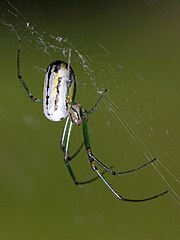
The spider species Araneus diadematus is commonly called the European garden spider, cross orbweaver, diadem spider, orangie, cross spider, and crowned orb weaver. It is sometimes called the pumpkin spider, although this name is also used for a different species, Araneus marmoreus. It is an orb-weaver spider found in Europe, where it is native, and North America, where it was introduced.

Nephila is a genus of araneomorph spiders noted for the impressive webs they weave. Nephila consists of numerous species found in warmer regions around the world. They are commonly called golden silk orb-weavers, golden orb-weavers, giant wood spiders, or banana spiders.

Peucetia viridans, the green lynx spider, is a bright-green lynx spider usually found on green plants. It is the largest North American species in the family Oxyopidae. This spider is common in the southern U.S., Mexico, Central America, and in many West Indies islands, especially Jamaica.

Leucauge is a spider genus of long-jawed orb weavers, with over 160 species and fully pantropical distribution.

Gasteracantha cancriformis is a species of orb-weaver spider. It is widely distributed in the New World.
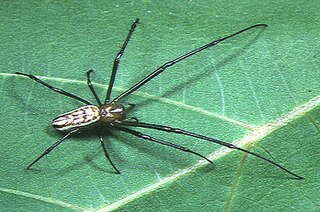
Leucauge celebesiana, commonly called the black-striped orchard spider, is a species of spider belonging to the family Tetragnathidae. It is found from India to China, Japan, Sulawesi and New Guinea.
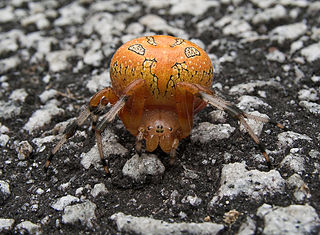
Araneus marmoreus, commonly called the marbled orbweaver, is a species of spider belonging to the family Araneidae. It is sometimes also called the pumpkin spider from the resemblance of the female's inflated abdomen to an orange pumpkin. It has a Holarctic distribution.

Grevillea venusta, commonly known as Byfield spider flower, is species of flowering plant in the family Proteaceae and is endemic to a small region of central eastern Queensland. It is an erect shrub with simple and/or divided leaves, the leaves or lobes narrowly oblong to narrowly elliptic, and clusters of green and yellow flowers with a deep maroon to purplish black style covered with white hairs.

Metepeira labyrinthea, the labyrinth orbweaver, is a spider, with thin legs and a round, bulbous abdomen It is a member of the genus Metepeira in the family Araneidae. The female’s length is 5.3 mm, its carapace 2.3 mm, abdomen 3.3 mm, and extended legs 18.4 mm. The carapace is brown or gray, and the abdomen is dark with a white pattern. The legs alternate pale brown and dark brown, and the sternum is dark brown with a longitudinal yellow mark. The male spider is three-quarters of the female’s length, or slightly larger, with a darker carapace and with greater contrast between dark and light areas of the legs. Metepeira are easily distinguished from other Araneidae by their light eye region, white median line on the sternum, relative length of the leg segments, small male palpus, weakly sclerotized epigyne and the special composite web.

Leucauge argyra is a spider and is known for being the host of the Hymenoepimecis argyraphaga, a Costa Rican or Puerto Rican parasitoid wasp. It is found in Asia, United States and Brazil. Leucauge argyra is known to be a colonial species, with spiders maintaining individual territories/orb webs within a scaffolding of shared support lines maintained by the group. Colonies of multi-generational individuals are often seen with some levels of size stratification.
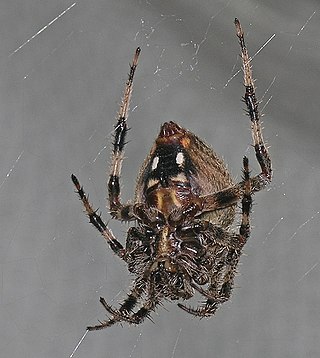
Neoscona crucifera is an orb-weaver spider in the family Araneidae. It is found in the United States from Maine to Florida in the east, to Minnesota in the Midwest, to Arizona in the southwest, southern California coastal communities and in Mexico. Its common names include Hentz orbweaver, spotted orbweaver, and barn spider. The name "barn spider" is also commonly used for a different spider, Araneus cavaticus.

Neoscona domiciliorum, commonly known as the spotted orbweaver or redfemured spotted orbweaver, is a spider in the family Araneidae. The specific epithet domiciliorum means "of dwellings" in Latin and refers to the fact that this species is often found living on buildings. Their bites are not known to cause serious harm in humans.
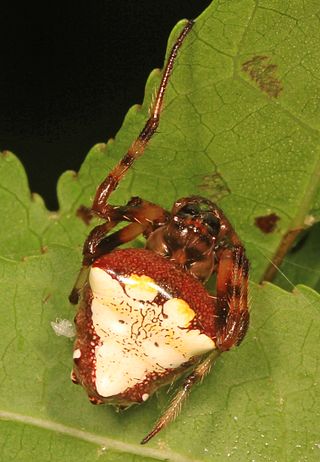
Verrucosa arenata, also known as the triangle orb weaver, arrowhead spider, and arrowhead orbweaver, is a species of orb-weaver spider found across North America. It is one of the few known large orb-weaver spiders that sits facing upwards in its web. Unlike most orb-weavers, which have bulbous abdomens, V. arenata has an abdomen that is pointy and triangular, shaped like the tip of an arrow. In females, the abdomen is colored white or yellow. Additionally, V. arenata uses reeling behavior in order to capture its prey, as its webs are stronger than that of most other orb weavers. The genus name Verrucosa means "warty" in Latin, referring to the small wartlike bumps on the spider's abdomen, while the specific epithet arenata derives from Latin arena, meaning "sand".

Araneus trifolium, the shamrock orbweaver, is a species of orb weaver in the family Araneidae. It is found throughout the USA and in Canada.
The abdomen of Araneus trifolium can have various colors. Most commonly, it is seen in a beige or brown color. Occasionally, the abdomen of the spider has a greenish touch to the brown color or it may even be yellow or orange. In the latter case, Araneus trifolium is sometimes confused with the orange orb weaver species Araneus marmoreus, also called pumpkin spider. The shamrock spider can be distinguished from other orb weaver species by the several white dots on its back. The legs of Araneus trifolium are usually brown or beige colored with several white bands around the joints.
The shamrock spider creates a web to catch its prey. Small flying insects who fly into the web will get stuck in the sticky net. The web of an orb weaver can be up to two feet (60cm) in diameter.
The bite of a shamrock spider can be painful but it is not dangerous for humans with effects comparable to a bee sting.

Araniella displicata, the sixspotted orbweaver, is a species of orb weaver in the spider family Araneidae. It is found in North America, Europe, a range from Russia to Kazakhstan, China, Korea, and Japan.

Argyrodes antipodianus, also known as the dew drop spider, is a species of kleptoparasitic spider from the cobweb spider family found in Australia, New Zealand and New Caledonia.
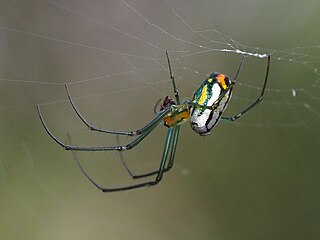
Leucauge argyrobapta, or Mabel's orchard orb weaver, is a species of long-jawed orb weaver in the spider family Tetragnathidae. It is found in Southern part of the USA, Mexico and Brazil, further testing must be done to see if it is found in more of Central and South America.

Leucauge granulata is one of the long-jawed orb weaver spiders. It is found in India, Sri Lanka, China, the Sunda Islands (Indonensia), Australia, and French Polynesia. Leucauge granulata marginata is known to inhabit New Guinea. Leucauge granulata rimitara in French Polynesia.

Leucauge mariana is a long-jawed orb weaver spider, native to Central America and South America. Its web building and sexual behavior have been studied extensively. Males perform several kinds of courtship behavior to induce females to copulate and to use their sperm.
